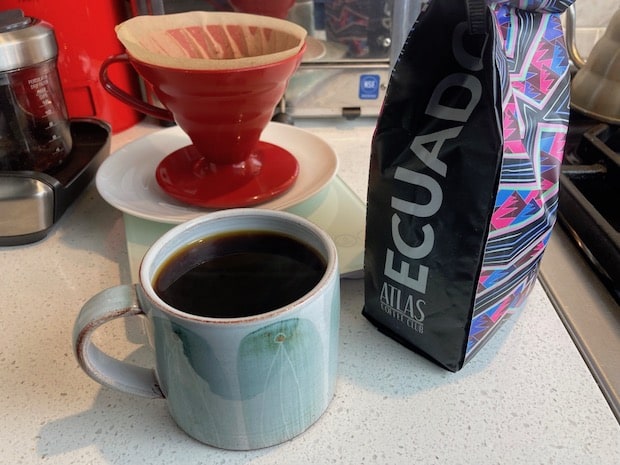Just so you know, as an Amazon Associate we earn from qualifying purchases made via bold red links, buttons or images.
Last Updated on December 15, 2023
I’m sipping a Peruvian dark roast from Atlas Coffee Club while I write this. I’m tasting caramel, lemon cream and chocolate. It’s all just a little bit smoky.
It’s delightful, and while it doesn’t quite carry me away to the cafes of Lima the way a lime-tinged tilapia ceviche would, it’s an interesting departure from the Papua New Guinea beans that Atlas sent to my door a month earlier.
And that’s kind of the whole point of an Atlas Coffee Club subscription.
The Atlas slogan is “Travel The World of Coffee,” because they send you freshly roasted coffee beans from a different region of the Coffee Belt every month. It’s like becoming a world traveler through exotic coffees, but in some ways it’s even better. World travelers generally get to plan their trips. With Atlas, you board the plane blindfolded every time. You never know where you’re going until the next box of coffee lands on your doorstep.
Order from Atlas now
How it works
Atlas Coffee Club is a coffee subscription service that is more like a coffee-of-the-month club. They source only specialty-grade, fair trade coffee, which means you always get quality coffee and the farmers who produce your coffee always get properly compensated. It’s a win-win.
You can do all your ordering on the Atlas Coffee Club website, which offers an easy user experience that walks you through your subscription options.
When you land there, your first task is to decide how much coffee you want, and how often.
Bag sizes
The standard shipment consists of a pair of 3/4-pound coffee bags, but you can order just a single bag if you want, or even a half-bag. If you’re a heavy coffee drinker you can order three bags, four bags, or a custom plan for the office.
Delivery schedule
Frequency of shipment is every two weeks or every four weeks. I don’t know how much you drink, but for me it’s a cup or two every day. That means a pair of these bags will last about two weeks.
If you’re in doubt, order less coffee on a more frequent schedule. Fresh coffee is best, and Atlas doesn’t even roast it until you place your order. They ship it on the same day they roast it. How great to have freshly roasted coffee arriving at your door every two weeks!
The shipping cost is about $5 per shipment within the U.S. (international shipping costs more), so if budget is a concern you may choose to forego a little freshness and get a larger volume shipped every four weeks.
Roast selection
You can state your roast preference when you set up your subscription. Choose from light-medium, medium-dark, or if you have no strong personal preferences, you can just ask Atlas to surprise you with whatever roast types they think work best for a particular coffee.
Whole bean or ground
If you want Atlas to grind the beans for your drip coffee maker before they ship, they will. But remember that ground coffee starts losing freshness immediately, and loses it much more quickly than whole beans. The whole point of a coffee subscription is consistent freshness, so I highly recommend keeping a grinder on hand, ordering whole beans, and grinding the beans yourself just before you brew.
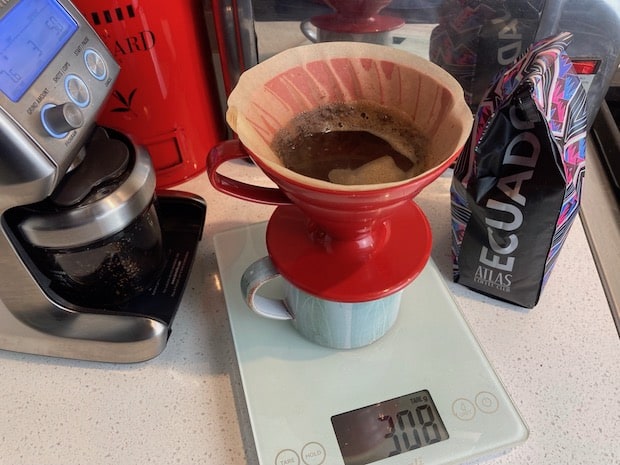
And that’s really all there is to it. Once you’ve made your choices, you enter your shipping address and your payment information. Soon, coffee will come to you. You never need to visit the store—or Starbucks—again.
You can change your preferences at any time by logging in to your account on the website and making adjustments.
If you need more details, Atlas has a in-depth FAQ page where they answer common questions about their service.
Cost of an Atlas Coffee Club subscription vs. competitors
I compared the cost of my typical 3/4-pound bag of premium Atlas coffee shipped every two weeks with what I would pay if ordered from other popular coffee subscription services.
Atlas stacked up very well against competition. In fact, they were by far the cheapest.
Cost of coffee subscriptions
| Subscription | Cost of 12-ounce bag |
|---|---|
| Atlas Coffee Club | $14.00 |
| Craft Coffee | $16.99 |
| Trade Coffee | $18.50 |
| Driftaway Coffee | $19.00 |
| Bean Box | $22.00 |
| Blue Bottle | $22.00 |
Keep in mind, that’s for my order. Costs may be different for you, depending on what subscription you choose, frequency of delivery, etc. But the table above should give you a general idea of how Atlas compares.
What you get
Atlas Coffee Club does packaging well. It’s one of my favorite things about it. You don’t just get the coffee. The beans come sealed in single-valve bags with the country of origin printed in big, bold letters on the side of the bag. A decorative pattern on the front and back of the bag seems inspired by the Indigenous art of whatever country it comes from. I’m not sure how authentic these patterns are, but you can see the resemblance.
Tucked underneath the bag of coffee you’ll find two things. The first is a postcard from the country you’re about to visit. Peru’s shows the sun rising over Machu Picchu. Written on the back, in over-the-top tourism brochure language, is a description of the country: Look down at the still, deep blue canyon waters, ancient braided grass between your fingers as you step lightly across Q’eswachaka, one of the last handwoven Incan bridges in the world.
Fine. Can we have a cup of coffee now? Not yet! There’s also a small card that fills you in on the type of coffee you’re about to drink. For coffee nerds, this beats the postcard. It describes the country’s coffee history, identifying the sub-region (complete with a silhouette map), growing altitude and washing process for this particular bean. Flip the card over and you’ll find tasting notes, brewing tips (in the form of a suggested brew method), and the roast level.
Whatever you think of the coffee, Atlas does a really nice job of creating surprise each month and injecting a little exoticism into what could otherwise be a dreary morning routine. You have to give them points for that.
Atlas Coffee Club review
My three months of coffee were complimentary—one of the perks of being a coffee blogger—but they gave me a good idea of what you could expect as an Atlas Coffee Club subscriber. Let’s go through what I received, month-by-month.
March: Papua New Guinea
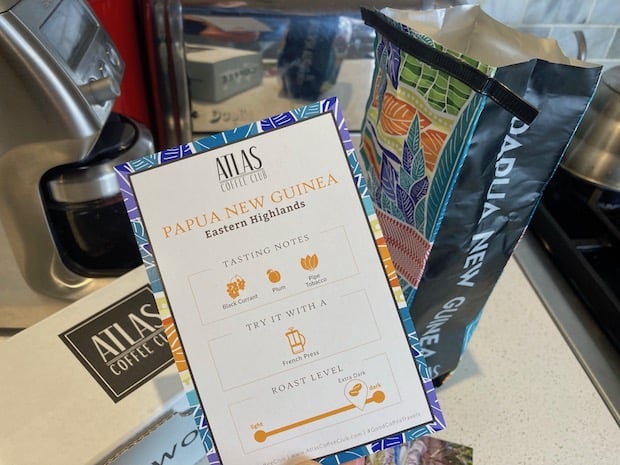
The coffee arrived in a standard cardboard box, inside of which were two smaller, identical cardboard boxes carrying the Atlas Coffee Club branding and design: the Atlas logo on top, a world map on each end, and the words “Travel the World of Coffee” circling the box on three sides.
Each box had its own bag of coffee inside, with the same distinctive Papua New Guinea pattern on each bag. Underneath the coffee, the traditional postcard and the smaller tip sheet that told me what I was getting.
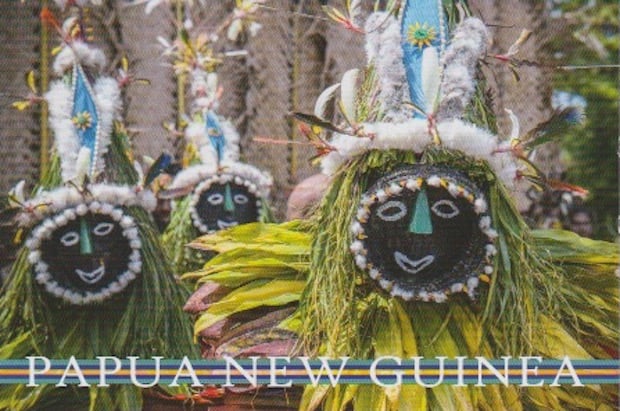
I received a dark roast and an extra dark roast. Both came from the Eastern Highlands of Papua New Guinea, grown at an altitude of 1400-2000 metres:
The tip sheet advised me to try the dark with my Chemex and the extra dark with my French press, but I had already resolved to brew everything with my Hario V60 pour-over cone. It’s my go-to brewing method, and I wanted a consistent brew method as I worked my way through these coffees so I could more easily compare the flavors.
The dark roast was like a smoky swirl of cinnamon, anise and honey. Quite nice indeed.
(I didn’t take notes when I brewed the extra dark, because really, how different could it be? I do remember enjoying it. For what it’s worth, my tip sheet tells me it features notes of black currant, plum and pipe tobacco.)
April: Peru

The Peruvian coffee in April came from Jaén in northern Peru, grown between 1600 and 1800 metres.
It arrived with advice to brew the dark roast with a Chemex and the extra dark with a moka pot. I personally don’t recommend a moka pot if you’re hoping to capture the nuance of a coffee. It’s not a subtle brewing method. However, extra dark is not a subtle roast, so they might actually work fine together.
Regardless, I wasn’t going to stray from my Hario V60 plan—at least not for the dark roast.
Again, the coffee had a smoky quality that I quite like in a darker roast. Within that I tasted sweet notes of caramel and a hint of lemon.
I decided to brew the extra dark with a French press. I love French press for a really dark roast, and I just had a hunch this was the way to go. The resulting brew was quite earthy, conjuring up wild mushrooms, chocolate and tobacco. It’s what I was looking for.
May: Ecuador
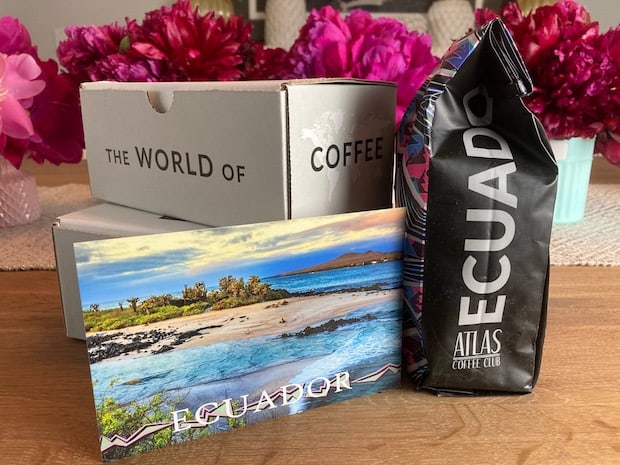
The Ecuadorean coffee I received in May included my first brush with a medium roast from Atlas. This was accompanied by a dark roast in the second box. The coffee had been grown high up at 1800-2000 metres, in the deep south of the country around Zamora:
As I looked at the map, it occurred to me that this was just an eight-hour drive north from the site in Peru where April’s coffee was grown. A quick peek at Google Street View suggests this would not be a stress-free drive:

But I digress.
A medium roast, in theory, should allow you to taste the flavor profile of the bean much more easily than you can with a dark or extra dark roast. Roast degree is the great equalizer in coffee. The darker you go, the harder it is to tell beans apart.
The theory held true. The Ecuadorean medium roast flashed the kind of flavors I hadn’t picked up in the earlier coffees. It had a little bit of that grapefruit-and-pine taste that has become so common in craft ales, but is considerably rarer in coffee. I detected some dried fruit as well—maybe prunes, maybe raisins, maybe Craisins.
Ultimately, it was a nice change to tuck into a coffee whose flavors weren’t obscured by that smoky, roasty mask that had enveloped the beans from March and April.
The verdict
Over three months, Atlas Coffee Club sent me three types of coffee from three different places of origin. Each month, half were roasted one way and half were roasted another way. All the coffee was good. I’m a fan of dark roast, and these were nicely done.
I wouldn’t say that each month was a massive departure from the last. Whatever differences there may have been between the beans were undoubtedly smoothed over somewhat by the generous roasting. It was really in the last month when I received the medium roast that things started to get interesting—although the coffee had been pleasant enough all along.
If you really want to be exposed each month to new, diverse, exotic flavors—and that’s really what it’s all about—then I would advise choosing lighter roasts when you order. As much as I enjoyed the darker roasts, they weren’t that easy to tell apart and I do think the uniformity would, over time, defeat the main purpose of this coffee subscription.
Either way, an Atlas subscription guarantees any coffee lover a steady flow of high-quality, single-origin coffee that’s always fresh. If your current routine involves buying a giant bag of beans from Costco and hanging on to it for a month or more, then an Atlas subscription may be an eye-opener for you. Try it. It’s a big world out there.
Order from Atlas now

